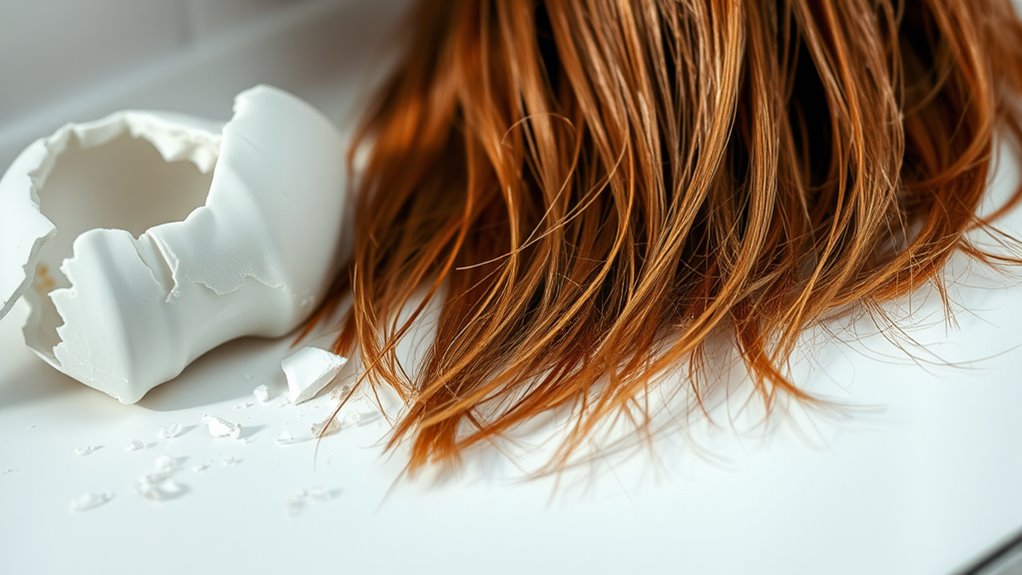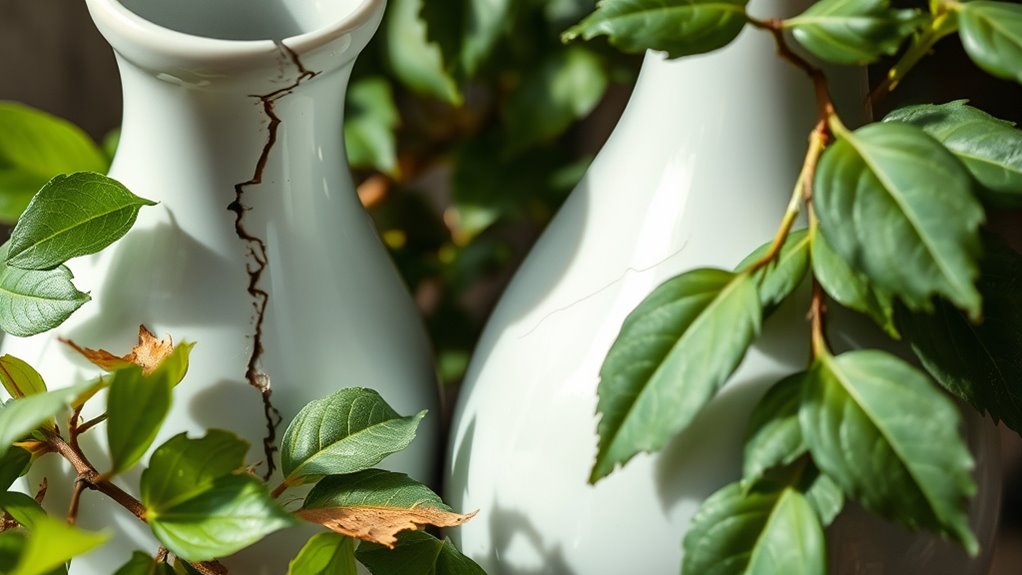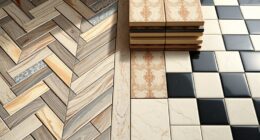To spot the difference, look closely at your hair loss. Shedding involves entire strands with roots still attached, often happening naturally and fluctuating daily. Breakage, on the other hand, results in uneven, shorter pieces without roots, caused by damage from styling or chemical treatments. If you notice short, uneven ends, it’s likely breakage. However, if most hairs fall out with roots, it’s shedding. Keep an eye out—you’ll discover more tips on how to manage both issues.
Key Takeaways
- Shedding involves hairs falling out with roots attached, indicating a natural hair cycle, while breakage results in shorter, uneven strands without roots.
- Shedding is a normal process, with 50-100 hairs lost daily, whereas breakage is caused by damage from heat, chemicals, or rough treatments.
- Shedding produces uniform hairs of full length, while breakage causes irregular, shorter hair pieces concentrated in specific areas.
- Signs of shedding include hair with roots still attached; breakage presents as frayed or damaged ends without roots.
- Managing shedding focuses on proper nutrition and scalp care, whereas preventing breakage requires strengthening treatments and moisture management.

Understanding the difference between breakage and shedding is essential if you’re trying to maintain healthy hair. While they might seem similar at first glance, they have distinct causes and implications. Recognizing these differences helps you tailor your hair care routine effectively. For example, if your hair is breaking easily, it could be due to issues like low hair porosity, which makes your strands more vulnerable to damage, or scalp irritation from harsh products. Shedding, on the other hand, often relates to natural hair growth cycles and isn’t necessarily a sign of poor health.
Understanding the differences between breakage and shedding helps tailor your hair care routine effectively.
When you notice hair falling out in clumps or strands that come out with a root attached, you’re likely observing shedding. This is a normal part of the hair cycle, where old hairs fall out to make room for new growth. Typically, shedding occurs daily, and losing about 50-100 hairs daily is considered healthy. If you’re experiencing more than that, it might be worth exploring underlying causes such as stress, hormonal changes, or nutritional deficiencies. On the flip side, if your hair is breaking off mid-shaft or near the scalp, that’s a sign of breakage. Breakage can happen for various reasons, like using heat styling tools excessively, over-processing with chemicals, or having hair with high porosity that struggles to retain moisture.
Understanding your hair’s porosity is key here. Hair porosity determines how well your hair can absorb and retain moisture. If your hair has high porosity, it’s more prone to breakage because its cuticles are often damaged or raised, making strands weaker and more susceptible to snapping. This type of damage can be exacerbated by scalp irritation, which often results from harsh shampoos, frequent chemical treatments, or product buildup. When the scalp is irritated, it becomes inflamed, and this inflammation can weaken hair follicles, leading to increased breakage.
To distinguish between shedding and breakage, observe how your hair falls out. Shedding generally involves entire strands with roots attached, indicating a natural cycle. Breakage results in shorter, uneven pieces without roots, often concentrated in specific areas. Managing these issues involves different approaches. For shedding, focusing on a balanced diet, reducing stress, and ensuring proper scalp care helps. For breakage, you need to strengthen your hair by avoiding harsh treatments, using moisturizing products suited to your hair porosity, and addressing scalp irritation. Additionally, understanding hair health fundamentals can provide insight into preventing both issues and promoting overall hair resilience.
Frequently Asked Questions
Can Hair Breakage Lead to Permanent Hair Loss?
Hair breakage doesn’t usually lead to permanent hair loss if you get proper breakage treatment. Many hair loss myths suggest that breakage causes baldness, but it’s often just damage to the hair shaft. To prevent future breakage, focus on strengthening your hair with nourishing products and gentle handling. While breakage can make hair look thinner temporarily, it’s not the same as shedding or permanent loss.
How Can I Prevent Shedding During Seasonal Changes?
Think of your hair as a delicate garden needing gentle care. To prevent shedding during seasonal changes, you should refine your detangling techniques, avoiding harsh tugging. Incorporate nourishing hair oiling routines to strengthen roots and keep strands resilient. Regularly massage your scalp to promote circulation, and protect your hair from environmental stressors. These mindful practices will help your hair weather seasonal shifts with grace and vigor.
What Hair Types Are More Prone to Breakage?
You’re more prone to breakage if you have hair with low elasticity or high porosity. Low elasticity means your hair struggles to stretch without snapping, while high porosity makes your hair more vulnerable to damage from environmental factors. To protect your hair, use gentle products that enhance elasticity and seal porosity, and avoid harsh chemicals. Proper hydration and regular trims also help minimize breakage and keep your hair healthy.
Does Frequent Washing Cause More Shedding?
Frequent washing doesn’t necessarily cause more shedding; in fact, many people lose around 50 to 100 hairs daily, which is normal. However, over-washing can lead to hair damage and affect scalp health if you use harsh shampoos or wash excessively. This damage can weaken hair strands, making shedding more noticeable. To protect your hair, use gentle products and avoid over-washing, allowing your scalp to stay healthy and minimize unnecessary shedding.
Are Natural Remedies Effective Against Hair Breakage?
Natural remedies can be effective against hair breakage if you use DIY treatments and herbal remedies regularly. Ingredients like coconut oil, aloe vera, and castor oil help strengthen your hair and reduce breakage. While they might not work overnight, consistent use nourishes your scalp and hair shaft. Remember, natural remedies are gentle and safe, making them a great addition to your hair care routine for healthier, stronger hair.
Conclusion
Now that you know the difference between breakage and shedding, you could be walking around with a hair disaster in the making—imagine losing entire strands or your hair falling out like a waterfall! Spotting the difference isn’t just helpful; it’s your secret weapon to saving your hair’s life. Don’t let confusion turn your gorgeous locks into a tragic mess. Stay alert, stay informed, and keep your hair thriving like a superstar!









